Licensing your invention to big brands can be a strategic way to bring your idea to a wider audience, but it’s not a simple process. From evaluating market potential to negotiating licensing terms, each step requires careful planning and execution. If you want to increase your chances of success and avoid common pitfalls, understanding the key stages involved is essential. Let’s explore the step-by-step approach that can help you navigate this complex but rewarding path.
Assessing Your Invention’s Market Potential
Before pursuing licensing, you need to determine if there’s a real demand for your invention. Conduct market validation by researching industry trends and potential competitors to gauge interest. You can also perform a patent search to ensure your idea is unique and not infringing on existing patents. Gather consumer feedback through surveys or focus groups to understand what buyers truly want. This step helps you assess if your invention solves a genuine problem and if people are willing to pay for it.
If the feedback is positive and market validation confirms demand, you’re more confident in moving forward. Skipping this step risks investing in an idea that mightn’t resonate with your target audience or attract licensing partners.
Protecting Your Intellectual Property
Protecting your intellectual property is a crucial step in the licensing process because it safeguards your invention from unauthorized use and guarantees you retain control over its commercialization. You should consider patent enforcement to stop infringers and maintain your rights.
Additionally, trademark registration helps protect your brand identity, ensuring others can’t imitate your logo or name. Properly securing these protections creates a solid foundation for licensing negotiations, giving big brands confidence in your ownership.
Creating a Compelling Presentation and Prototype
Creating a compelling presentation and prototype is essential to capturing the interest of potential licensees and demonstrating the value of your invention. Effective prototype development provides a tangible, visual proof of how your invention works, making it easier for others to understand its benefits.
Sharpen your presentation skills to clearly communicate your invention’s unique advantages and market potential. Focus on showcasing your prototype confidently, highlighting key features and solutions it offers.
A well-crafted presentation paired with a functional prototype can substantially increase your chances of licensing success, as it builds credibility and convinces brands of your invention’s commercial viability.
Researching and Targeting the Right Brands
Once you have a solid prototype and presentation ready, the next step is to identify which brands are most likely to be interested in your invention. Conduct a thorough market analysis to understand industry trends and consumer needs.
Look for brands whose products align with your invention’s purpose and values, ensuring strong brand alignment.
Research competitors and their licensing strategies to spot gaps or opportunities.
Focus on brands that target your ideal customer base and have a history of licensing innovations.
This targeted approach saves time and increases your chances of finding a good partner, setting the stage for successful licensing negotiations.
Approaching and Pitching to Big Brand Decision-Makers
Approaching and pitching to big brand decision-makers requires a strategic and confident approach.
Start with thorough market research to understand their needs, preferences, and current branding strategies.
Tailor your pitch to align your invention with their brand values and market positioning.
Demonstrate how your product complements or enhances their existing lineup.
Confidence is key—be clear, concise, and focus on the value your invention offers.
Use insights from your research to craft compelling messaging.
Negotiating Licensing Agreements
After capturing the interest of a big brand decision-maker with a compelling pitch, the next step is to negotiate a licensing agreement that benefits both parties.
You’ll want to clearly define licensing terms, including the scope, duration, and exclusivity. Discuss royalty rates, making sure they reflect your invention’s value while remaining attractive to the brand.
Be prepared to negotiate these terms to reach a fair deal. Remember, a well-structured agreement protects your rights and ensures you’re compensated appropriately.
Stay confident, ask questions, and don’t rush—negotiating effectively establishes the foundation for a successful licensing relationship.
Managing the Licensing Relationship and Next Steps
Effective management of your licensing relationship is essential to ensuring both parties fulfill their obligations and maximize the partnership’s success. Regular contract management keeps you aligned with licensing terms, deadlines, and deliverables.
It’s also vital to establish a system for royalty tracking, so you accurately monitor payments and royalties owed. Stay proactive by maintaining clear communication, reviewing performance metrics, and addressing issues promptly.
Next steps include scheduling regular check-ins, updating licensing agreements if needed, and planning future collaborations. By actively managing the relationship, you safeguard your invention’s value and build a strong foundation for ongoing success.
Conclusion
Licensing your invention to big brands can be a rewarding journey if you follow these steps carefully. By evaluating market potential, protecting your IP, and creating a strong prototype, you set a solid foundation. Target the right brands and pitch confidently, then negotiate wisely. Keep communication open and nurture the relationship for long-term success. With persistence and strategic planning, you can turn your idea into a licensed product that reaches a wide audience. To learn more on how to bring your idea or invention to market, visit us online at Inventors IPO.

